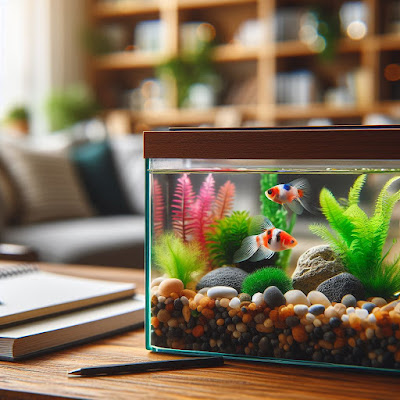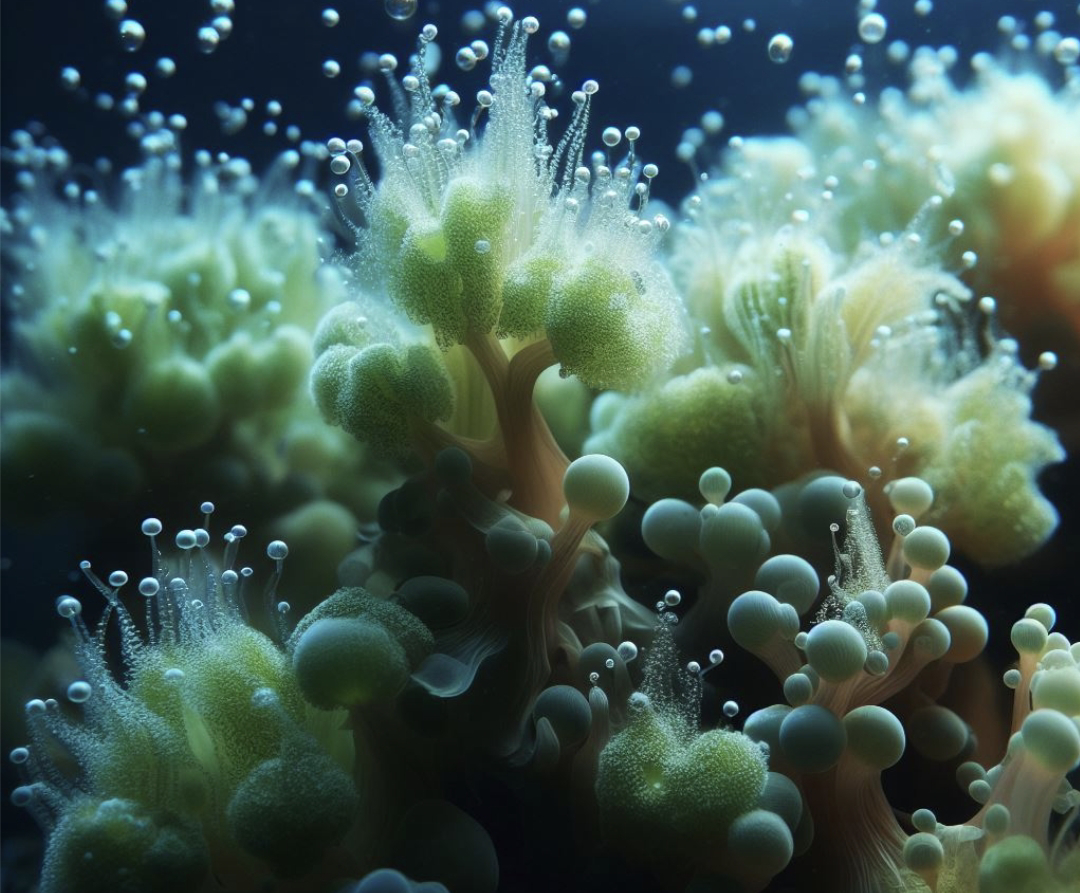Setting up a Planted Tank - Don’t Forget the CO2 System!
When owning a freshwater system, one of the next coolest things you can do besides finding your perfect fish is really getting your plants going. Whether it be big-leafed Anubias and Angelfish or Java Moss and shrimp, we feel you. Scanning through aquascapers photos is like traveling through a real-life fairytale, you literally might catch a glimpse of a mermaid or two! To get to that point though it isn’t all fun and games. Baby tears and smaller grasses are easiest when grown from seed, which means planning ahead of time to start a brand new tank, adding plants into an already-filled system can work, but they need to be fully grown or tied down. You might need to add something other than gravel at the bottom as well if you just have a basic tank.
Plants are great for your aquarium in that they help regulate and bring essential things, like bacteria. Plants take in carbon dioxide and put out oxygen, the fish inhale the oxygen in a nice little cycle, as long as you have the right amount of fish and plants. The smaller the tank, the more sensitive it is, and it can be hard to tell as the plants and fish grow whether your ratio that was working is going to stay that way. Fish create ammonia that creates nitrifying bacteria, the bacteria is taken in by plants and put out as oxygen for the fish. You really can’t have too many plants unless you have absolutely no room for fish to swim, however, you can have too many fish. If the fish put out too much ammonia then algae will begin to take over, too many fish overall will actually starve them to death as they are deprived of oxygen if the ammonia spike doesn’t kill them first. Finding the perfect balance is crucial and will create a happy and healthy tank. The issue with wanting a lot of plants (not at all a bad thing) is that at some point they won’t have enough carbon dioxide and they will start to die. Dying plants brings us right back to the beginning cycle that basically ends in the death of your aquarium.
Adding CO2 to your planted tank is a vital component of a successful aquascape, as it ensures that your aquatic plants thrive, maintaining a harmonious and healthy ecosystem. While the need for CO2 supplementation largely depends on the type and quantity of plants you have, there are some general guidelines to help you determine when and how to add CO2 to your tank.
1. Plant Density: If you have a densely planted tank with a wide variety of plant species, it's highly likely that they will consume carbon dioxide faster than it's naturally available. In such cases, introducing a CO2 system is a good idea.
2. Lighting Intensity: Strong lighting, especially in high-tech setups with powerful LED fixtures, can lead to increased photosynthesis in your plants. More photosynthesis means your plants will demand more CO2 for growth. If you've invested in high-intensity lighting, consider CO2 supplementation to match the increased metabolic rate of your plants.
3. Plant Health: Keep a close eye on your plants. If you notice that they are showing signs of slow growth, yellowing leaves, or struggling to maintain their vibrancy, it might be time to consider adding CO2. Healthy, thriving plants are the primary indicators of a well-balanced aquarium.
4. Algae Growth: If you're experiencing persistent algae issues in your tank, it may be due to an imbalance between the CO2 consumption of your plants and the available carbon dioxide. By increasing CO2 levels, you can often reduce the dominance of algae.
5. Tank Size: Smaller tanks tend to experience more significant fluctuations in carbon dioxide levels. A well-regulated CO2 system can help stabilize these levels, ensuring consistent plant growth.
6. Monitoring and Adjusting: Invest in a reliable CO2 monitoring system and be prepared to make adjustments as necessary. It's important to maintain a stable and consistent CO2 concentration within your tank, so your plants don't experience fluctuations in their growth conditions.
There are different methods for introducing CO2 into your planted tank, ranging from simple DIY setups using citric acid and baking soda to more advanced pressurized systems with solenoid valves and pH controllers. The choice depends on your level of commitment, budget, and the specific needs of your planted aquarium.
Keep in mind that while adding CO2 can greatly benefit your plants, it's important not to overdo it. Excessive CO2 can be harmful to your fish, so it's crucial to strike a balance between plant growth and fish health. Use a drop checker or monitor the pH and carbonate hardness (KH) of your tank water to ensure the CO2 levels are within a safe range.
In conclusion, if you're passionate about creating a stunning planted aquarium, a CO2 system is an essential component to achieve lush and vibrant plant growth. By paying attention to the cues provided by your plants and maintaining a consistent and appropriate CO2 level, you can create a thriving underwater ecosystem that's not only visually captivating but also conducive to the well-being of your aquatic inhabitants. So, don't forget the CO2 system if you want to take your planted tank to the next level!
Plants are great for your aquarium in that they help regulate and bring essential things, like bacteria. Plants take in carbon dioxide and put out oxygen, the fish inhale the oxygen in a nice little cycle, as long as you have the right amount of fish and plants. The smaller the tank, the more sensitive it is, and it can be hard to tell as the plants and fish grow whether your ratio that was working is going to stay that way. Fish create ammonia that creates nitrifying bacteria, the bacteria is taken in by plants and put out as oxygen for the fish. You really can’t have too many plants unless you have absolutely no room for fish to swim, however, you can have too many fish. If the fish put out too much ammonia then algae will begin to take over, too many fish overall will actually starve them to death as they are deprived of oxygen if the ammonia spike doesn’t kill them first. Finding the perfect balance is crucial and will create a happy and healthy tank. The issue with wanting a lot of plants (not at all a bad thing) is that at some point they won’t have enough carbon dioxide and they will start to die. Dying plants brings us right back to the beginning cycle that basically ends in the death of your aquarium.
So how do you know when to add CO2 to your tank? Well, it never hurts if you have plants.
Adding CO2 to your planted tank is a vital component of a successful aquascape, as it ensures that your aquatic plants thrive, maintaining a harmonious and healthy ecosystem. While the need for CO2 supplementation largely depends on the type and quantity of plants you have, there are some general guidelines to help you determine when and how to add CO2 to your tank.
1. Plant Density: If you have a densely planted tank with a wide variety of plant species, it's highly likely that they will consume carbon dioxide faster than it's naturally available. In such cases, introducing a CO2 system is a good idea.
2. Lighting Intensity: Strong lighting, especially in high-tech setups with powerful LED fixtures, can lead to increased photosynthesis in your plants. More photosynthesis means your plants will demand more CO2 for growth. If you've invested in high-intensity lighting, consider CO2 supplementation to match the increased metabolic rate of your plants.
3. Plant Health: Keep a close eye on your plants. If you notice that they are showing signs of slow growth, yellowing leaves, or struggling to maintain their vibrancy, it might be time to consider adding CO2. Healthy, thriving plants are the primary indicators of a well-balanced aquarium.
4. Algae Growth: If you're experiencing persistent algae issues in your tank, it may be due to an imbalance between the CO2 consumption of your plants and the available carbon dioxide. By increasing CO2 levels, you can often reduce the dominance of algae.
5. Tank Size: Smaller tanks tend to experience more significant fluctuations in carbon dioxide levels. A well-regulated CO2 system can help stabilize these levels, ensuring consistent plant growth.
6. Monitoring and Adjusting: Invest in a reliable CO2 monitoring system and be prepared to make adjustments as necessary. It's important to maintain a stable and consistent CO2 concentration within your tank, so your plants don't experience fluctuations in their growth conditions.
There are different methods for introducing CO2 into your planted tank, ranging from simple DIY setups using citric acid and baking soda to more advanced pressurized systems with solenoid valves and pH controllers. The choice depends on your level of commitment, budget, and the specific needs of your planted aquarium.
Check Out a CO2 Kit>
Check Out Live Plant Bundles>
Keep in mind that while adding CO2 can greatly benefit your plants, it's important not to overdo it. Excessive CO2 can be harmful to your fish, so it's crucial to strike a balance between plant growth and fish health. Use a drop checker or monitor the pH and carbonate hardness (KH) of your tank water to ensure the CO2 levels are within a safe range.
In conclusion, if you're passionate about creating a stunning planted aquarium, a CO2 system is an essential component to achieve lush and vibrant plant growth. By paying attention to the cues provided by your plants and maintaining a consistent and appropriate CO2 level, you can create a thriving underwater ecosystem that's not only visually captivating but also conducive to the well-being of your aquatic inhabitants. So, don't forget the CO2 system if you want to take your planted tank to the next level!









.png)
